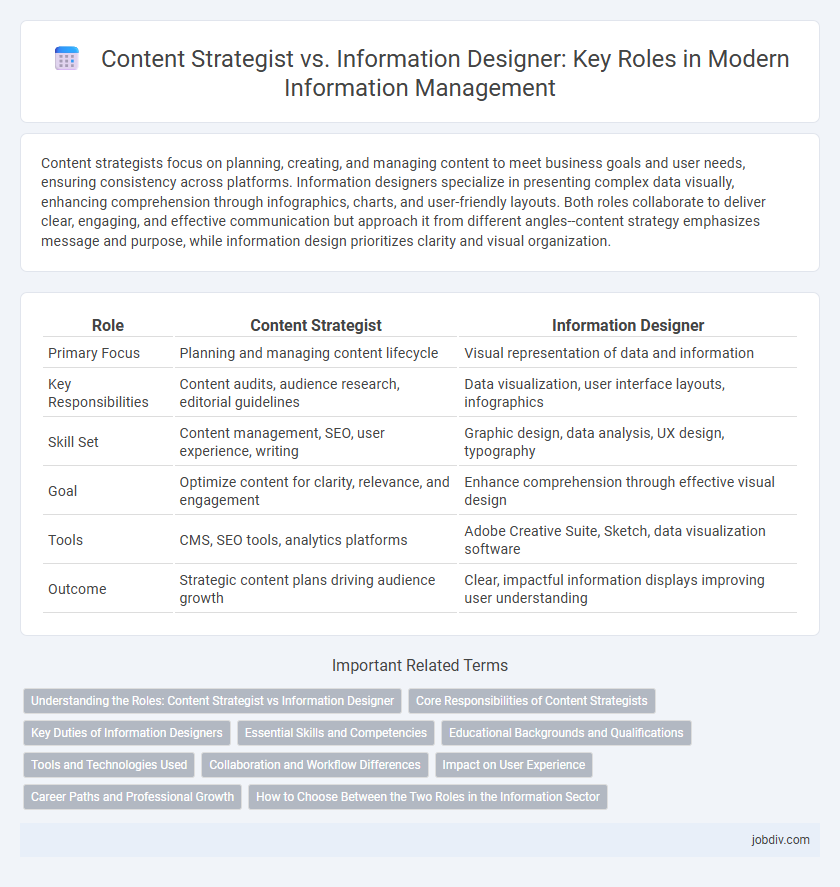Content strategists focus on planning, creating, and managing content to meet business goals and user needs, ensuring consistency across platforms. Information designers specialize in presenting complex data visually, enhancing comprehension through infographics, charts, and user-friendly layouts. Both roles collaborate to deliver clear, engaging, and effective communication but approach it from different angles--content strategy emphasizes message and purpose, while information design prioritizes clarity and visual organization.
Table of Comparison
| Role | Content Strategist | Information Designer |
|---|---|---|
| Primary Focus | Planning and managing content lifecycle | Visual representation of data and information |
| Key Responsibilities | Content audits, audience research, editorial guidelines | Data visualization, user interface layouts, infographics |
| Skill Set | Content management, SEO, user experience, writing | Graphic design, data analysis, UX design, typography |
| Goal | Optimize content for clarity, relevance, and engagement | Enhance comprehension through effective visual design |
| Tools | CMS, SEO tools, analytics platforms | Adobe Creative Suite, Sketch, data visualization software |
| Outcome | Strategic content plans driving audience growth | Clear, impactful information displays improving user understanding |
Understanding the Roles: Content Strategist vs Information Designer
A Content Strategist focuses on planning, developing, and managing content to meet business goals and target audience needs, emphasizing brand voice and user engagement. An Information Designer specializes in organizing and structuring information visually to enhance comprehension and usability through clear layouts, diagrams, and data visualization. Understanding the distinct roles highlights how Content Strategists drive message effectiveness while Information Designers optimize information clarity and accessibility.
Core Responsibilities of Content Strategists
Content strategists primarily focus on planning, developing, and managing content to align with business goals and user needs. They conduct audience research, create content frameworks, and establish editorial guidelines to ensure consistency and effectiveness across platforms. Their role centers on optimizing content lifecycle, enhancing user engagement, and supporting brand messaging through strategic content decisions.
Key Duties of Information Designers
Information Designers specialize in organizing and presenting data to enhance user comprehension and engagement by creating intuitive visual hierarchies, infographics, and interactive interfaces. Their key duties include analyzing complex information, applying principles of graphic design and cognitive science, and ensuring clarity through layout, typography, and color schemes. They collaborate with UX designers and content strategists to transform raw content into accessible, user-friendly formats optimized for different platforms and audiences.
Essential Skills and Competencies
Content Strategists excel in audience analysis, SEO optimization, and content lifecycle management, ensuring that messaging aligns with brand goals and drives engagement. Information Designers specialize in data visualization, user experience (UX) principles, and information architecture, transforming complex data into clear, accessible formats. Both roles require strong communication skills, analytical thinking, and proficiency with digital tools but focus on different aspects of content creation and presentation.
Educational Backgrounds and Qualifications
Content Strategists typically hold degrees in marketing, communications, or journalism, with a strong emphasis on writing, research, and audience analysis. Information Designers often possess qualifications in graphic design, human-computer interaction, or information architecture, combining visual communication skills with technical proficiency. Both roles benefit from certifications in digital tools and user experience to enhance strategic content delivery and information clarity.
Tools and Technologies Used
Content Strategists primarily utilize content management systems (CMS) such as WordPress, analytics tools like Google Analytics, and SEO tools including SEMrush or Ahrefs to plan and optimize content for target audiences. Information Designers focus on data visualization software such as Adobe Illustrator, Tableau, and Figma to create clear and effective visual representations of complex information. Both roles increasingly incorporate collaboration platforms like Slack and project management tools like Trello or Asana to streamline communication and workflows.
Collaboration and Workflow Differences
Content strategists focus on planning, organizing, and managing content to align with business goals and audience needs, while information designers specialize in structuring and visually presenting data for clarity and usability. Collaboration often involves content strategists defining the messaging framework and goals, with information designers translating these into intuitive layouts and interactive designs. Workflow differences emerge as content strategists prioritize content development timelines and editorial processes, whereas information designers emphasize prototyping, user testing, and iterative design improvements.
Impact on User Experience
Content Strategists shape user experience by developing clear, purpose-driven content frameworks that guide users through meaningful interactions. Information Designers enhance user experience by organizing and presenting data visually, ensuring information is accessible and easily understood. Together, they optimize usability and engagement by aligning content structure with intuitive information architecture.
Career Paths and Professional Growth
Content strategists focus on planning, creating, and managing content to meet business goals, often advancing into roles like content director or digital marketing manager. Information designers specialize in organizing and presenting complex data visually, with career growth leading to positions such as UX designer or information architect. Both careers require strong analytical skills and offer opportunities in digital media, user experience, and information management sectors.
How to Choose Between the Two Roles in the Information Sector
Choosing between a Content Strategist and an Information Designer depends on your project's focus: Content Strategists excel in developing and managing content plans to meet business goals, while Information Designers specialize in presenting complex data clearly and engagingly. Assess whether your priority is crafting compelling narratives and aligning content with marketing objectives or creating intuitive visualizations that enhance user understanding. Evaluating the desired outcome--strategic content delivery versus effective information visualization--guides the optimal role selection in the information sector.
Content Strategist vs Information Designer Infographic

 jobdiv.com
jobdiv.com